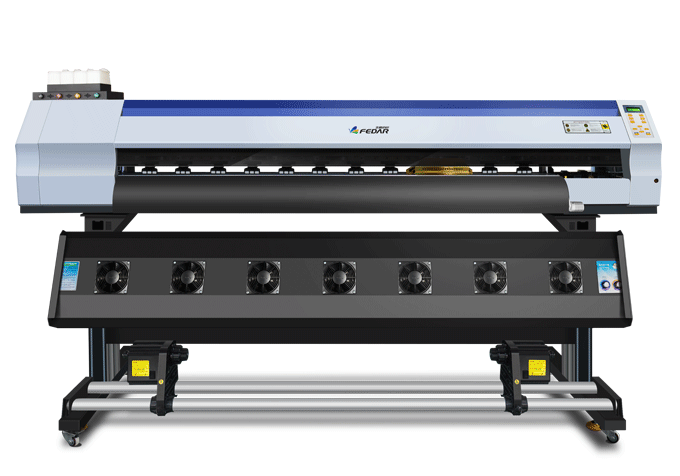Transfer printing was invented in the 1950s. It uses heat and pressure to sublime the dye to promote the peeling of the ink layer from the paper and transfer the pattern on the transfer paper to the fabric, that is, the sublimation method. This method has the advantages of convenient operation, high authenticity rate of finished products, low equipment investment cost, etc. However, this heat transfer printing technology mostly uses disperse dyes to transfer printing onto polyester fabrics
heat transfer printing dyes have a narrow range of options and applications, and many necessary dyes will decompose into carcinogenic aromatic amines during transfer. In addition, since the sublimation heat transfer printing inks are all prepared with solvents, there are great difficulties in the recycling of waste transfer paper, and the production of transfer paper has serious environmental pollution. Due to the above factors, the entire production process of printing transfer paper and transferring to fabrics cannot meet the 0eko-Tex standard required by developed countries' markets, resulting in products lacking competitiveness and failing to break through the green barriers of the market.

Cold transfer printing technology
Cold transfer printing is named after the traditional heat transfer printing technology. It first uses a printing method to print the pattern or text to be printed on special paper with a suitable dye ink, and then prints it into a transfer printing paper. The fabric after alkali padding and the transfer paper enter the transfer roller at the same time. The dye ink side of the transfer printing paper is closely attached to the printed fabric, and the dye ink is detached and peeled from the paper by pressure to transfer the printing. The pattern or text on the paper is transferred to the fabric. Therefore, cold transfer printing is also called "wet transfer printing". The process flow is as follows:
Transfer printing carrier printing paper printing pattern pattern-cold transfer printing cold batch fixing-washing a certain type of cold transfer printing has a wide range of applications, and can be used for woven or knitted fabrics, including cotton, linen, silk, viscose, etc.
Features of cold transfer printing technology
In response to the severe situation of raising the threshold of the international market, my country's printing and dyeing development must pay attention to protecting the environment, improving the efficiency of water resources, vigorously promoting clean production, and developing and promoting various new technologies that reduce pollution, save energy and promote health based on the concept of ecological and environmental protection. And new products. The emerging cold transfer printing technology has significant advantages in terms of energy saving, consumption reduction, pollution discharge, and increased added value of textile printing due to the uniqueness of its process.
(1) Energy saving and low consumption
The new technology of cold transfer printing has significant advantages in terms of energy saving, consumption reduction, pollution emission and increasing the added value of textile printing due to its unique process. Compared with traditional printing, it can save energy by 65%, save dye by 40%, save 2/3 of water consumption, and make the recovery rate of discharged water reach 92%. The coloring technology enables the dye transfer rate to reach 95%, achieving the principle of maximizing the utilization of the dye, leaving no residue and no pollution. Simultaneously. In the production process, cold transfer printing omits the traditional heat printing and dyeing processes such as dyeing, washing, bleaching, etc., and the production costs such as time, personnel, and materials are reduced.
(2) Green and environmental protection
Through the continuous development of cold transfer printing from a single barrier coating to a composite coating, it is now possible to realize paperless transfer printing with a conductive tape or temporary carrier. The temporary carrier for printing has good barrier properties to dye inks, and can reach a high transfer rate of over 95%. The color paste of cold transfer printing does not contain urea, which reduces air and water pollution: the color paste has sufficient permeability, good dye transfer, high fixation rate, good reproducibility, high yield, and reduced The generation of production waste.
(3) Respond quickly according to market demand
In traditional printing, after pattern design, plate making, engraving, etc., the dye ink is printed on the transfer paper with a printing machine, and then transferred to the textile, and then the large sample can be printed after the customer's confirmation. The cold transfer printing can simplify the complex procedures of the printing and dyeing industry, and meet the rapid response needs of the market from design, sample confirmation, order placement, mass production and sales of printing. In addition, the patterns of cold transfer printing are lifelike, rich in three-dimensional effects, strong artistry, simple in process, and the process is energy-saving and environmentally friendly, which fully meets the requirements of the "Technical Policy for Wastewater Pollution Prevention and Control in Printing and Dyeing Industry".
(4) Increase added value
The printing market is fiercely competitive, and cold transfer printing adopts the principle of four-color separation, which can reflect the photo effect of rich layers and unlimited colors on the fabric, which is comparable to digital printing. The pattern design is easy to change, and the colors are diversified. There are halftones (colors between shades) and light colors: basic colors (patterns) that are strongly drawn; high uniformity; almost no defective products. Cold transfer printing is not limited by the fabric structure, whether it is woven fabric or knitted fabric, thick or thin, it can transfer printing. For some thick and compact fabrics, double-sided two-layer printing paper can also be used to transfer at the same time to achieve the effect of double-sided printing and increase the added value of the fabric.

Cold transfer printing is a comprehensive manifestation of technological innovation, energy conservation, environmental protection, and digital printing effects. It basically meets the requirements of cleaner production. It is one of the most advanced textile printing technologies in the world with color fixation, low energy consumption and low pollution emissions at room temperature. A revolution in the textile printing and dyeing industry.
Zhengzhou New Century Digital Technology Co., Ltd.,- (Fedar Printer:
www.fedar.net) has exquisite production technology and professional technical team in the field of fedar sublimation printers,inkjet heat transfer printer,digital fabric printer,etc., focusing on providing comprehensive solution for field of inkjet printing.
Fedar sublimation printer company has absorbed and condensed a group of high-quality professional technicians and enterprising young management groups, formed a strong technical team and increasingly rigorous management system,providing customers with high-quality printing machines and services,and has established a good brand image and reputation in industry.




